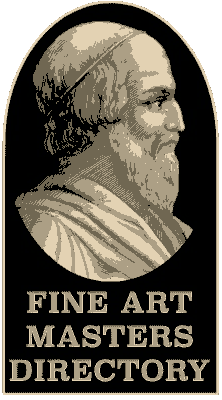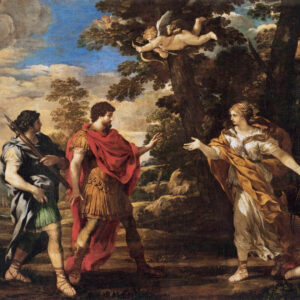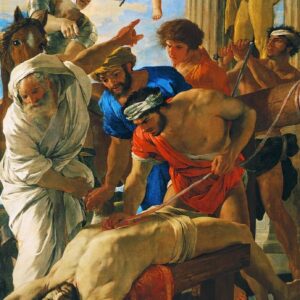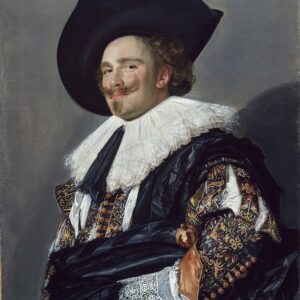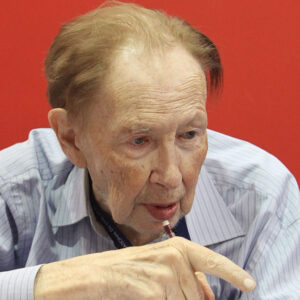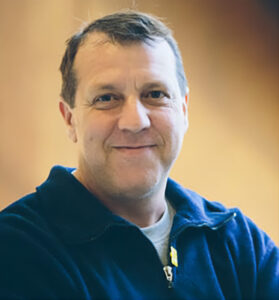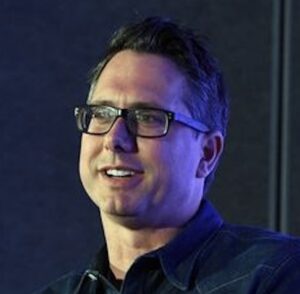Annibale Carracci (Italian pronunciation: [anˈniːbale karˈrattʃi]; November 3, 1560 – July 15, 1609) was an Italian painter and instructor, active in Bologna and later in Rome. Along with his brother and cousin, Annibale was one of the progenitors, if not founders of a leading strand of the Baroque style, borrowing from styles from both north and south of their native city, and aspiring for a return to classical monumentality, but adding a more vital dynamism. Painters working under Annibale at the gallery of the Palazzo Farnese would be highly influential in Roman painting for decades.
The 17th-century critic Giovanni Bellori, in his survey entitled Idea, praised Carracci as the paragon of Italian painters, who had fostered a “renaissance” of the great tradition of Raphael and Michelangelo. On the other hand, while admitting Caravaggio‘s talents as a painter, Bellori deplored his over-naturalistic style, if not his turbulent morals and persona. He thus viewed the Caravaggisti styles with the same gloomy dismay. Painters were urged to depict the Platonic ideal of beauty, not Roman street-walkers. Yet Carracci and Caravaggio patrons and pupils did not all fall into irreconcilable camps. Contemporary patrons, such as Marquess Vincenzo Giustiniani, found both applied showed excellence in maniera and modeling.[2]
By the 21st century, observers had warmed to the rebel myth of Caravaggio, and often ignored the profound influence on art that Carracci had. Caravaggio almost never worked in fresco, regarded as the test of a great painter’s mettle. On the other hand, Carracci’s best works are in fresco. Thus the somber canvases of Caravaggio, with benighted backgrounds, are suited to the contemplative altars, and not to well-lit walls or ceilings such as this one in the Farnese. Wittkower was surprised that a Farnese cardinal surrounded himself with frescoes of libidinous themes, indicative of a “considerable relaxation of counter-reformatory morality”. This thematic choice suggests Carracci may have been more rebellious relative to the often-solemn religious passion of Caravaggio’s canvases. Wittkower states Carracci’s “frescoes convey the impression of a tremendous joie de vivre, a new blossoming of vitality and of an energy long repressed”.
In the 21st century, most connoisseurs making the pilgrimage to the Cerasi Chapel in Santa Maria del Popolo would ignore Carracci’s Assumption of the Virgin altarpiece (1600–1601) and focus on the flanking Caravaggio works. It is instructive to compare Carracci’s Assumption[3] with Caravaggio’s Death of the Virgin. Among early contemporaries, Carracci was an innovator. He re-enlivened Michelangelo’s visual fresco vocabulary, and posited a muscular and vivaciously brilliant pictorial landscape, which had been becoming progressively crippled into a Mannerist tangle. While Michelangelo could bend and contort the body into all the possible perspectives, Carracci in the Farnese frescoes had shown how it could dance. The “ceiling”-frontiers, the wide expanses of walls to be frescoed would, for the next decades, be thronged by the monumental brilliance of the Carracci followers, and not Caravaggio’s followers.
In the century following his death, to a lesser extent than Bernini and Cortona, Carracci and baroque art in general came under criticism from neoclassic critics such as Winckelmann and even later from the prudish John Ruskin, as well as admirers of Caravaggio. Carracci in part was spared opprobrium because he was seen as an emulator of the highly admired Raphael, and in the Farnese frescoes, attentive to the proper themes such as those of antique mythology.
